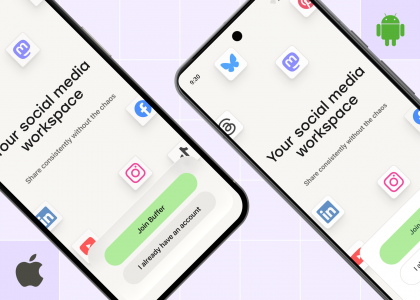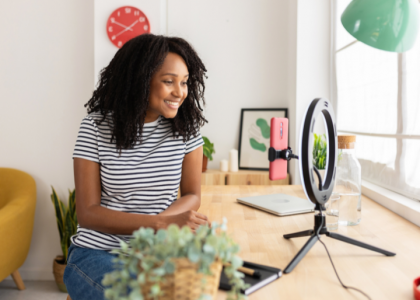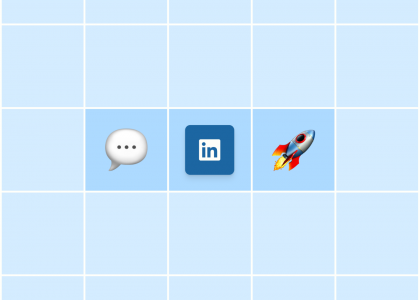*taps mic* Are you listening?
LinkedIn allows creators and brands to set up aptly named Audio Events on the platform similar to X/Twitter Spaces or Clubhouse. With the audio feature, you can live-stream interactive conversations with your LinkedIn audience — and beyond.
LinkedIn Audio Events offer a unique way to engage with your professional network in real-time, providing opportunities for meaningful discussions, knowledge sharing, and community building.
Whether you’re creating space for your community to speak on relevant topics or giving time to your audience to connect more deeply, LinkedIn Audio Events provides a versatile and effective medium.
In this article, we cover everything you need to know about LinkedIn Audio Events, from setting them up to best practices for hosting and promoting them.
What are LinkedIn Audio Events?
The LinkedIn Audio Events feature allows creators and brands to do exactly what it sounds like — host audio-only events. This functionality opens up new possibilities for engaging with your audience in a dynamic and interactive way without the need for video.
Using this feature, LinkedIn users can host virtual events that last anywhere from 15 minutes to 3 hours. During these events, participants can join, listen, and actively contribute to the conversations, creating a lively and engaging environment. Additionally, thes events support panel discussions, enabling multiple experts to co-host and share their insights simultaneously.
Whether you’re a brand, creator, or individual growing your personal brand, this feature allows you to open up to more professional connections, share valuable knowledge, and spark meaningful conversations within your industry.
Why you should host a LinkedIn Audio Event
Thanks to LinkedIn’s clear focus on the professional community, there’s a clear audience and expected return on investment with Audio Events.
In addition to this clear benefit, here are some other reasons you should consider hosting LinkedIn Audio Events:
Engage your audience: Go beyond text and video to live conversations that allow your audience to engage with you on a different level than pre-determined content.Host talks from anywhere: The lack of emphasis on video makes LinkedIn Audio Events more appealing for casual conversations in a professional setting.Inspire community: Attendees can engage with others and follow anyone who interests them. Jayde Powell, an experienced Audio Events creator, highlights this as a specific benefit of the feature (more on this below).
How to set up a LinkedIn Audio Event
To set up a new event page:
On your LinkedIn homepage, check the left side of your screen for the Events section. Tap the + icon Upload a cover imageUnder the Event format box, choose Audio Event.Type in the event details: title, details, date, time, and description. Invite co-hosts if you have any. Make sure they’ve agreed to speak on the panel!Click Next to go to the posting window. Here, you can share as much detail as possible about your event to your feed to let your audience know about your upcoming event.Click Post!
Case study inspiration for your next Audio Event
If you’re looking for inspiration to set up your LinkedIn Audio Event, look no further than #CreatorTeaTalk with Jayde Powell.
Jayde runs an event series called Creator Tea Talk that holds valuable conversations about the creator economy.
Her strategy involves basing episodes around cultural conversations combined with evergreen topics for creators.
The sessions are usually well-attended, with an average of 100+ attendees per session, and vary between solo Q&A-oriented discussions and panels.
Tips and best practices for hosting a successful event on LinkedIn
Hosting a successful LinkedIn Audio Event may seem simple on the surface, but requires thoughtful planning and execution.
Here are some essential tips to ensure your event is engaging and impactful:
Plan ahead: Outline your topics and key points to ensure a smooth flow. Preparing a detailed agenda will help you stay on track and cover all the important aspects of your discussion. Audio Events have a time limit of 3 hours, so make sure to allocate time for Q&A sessions to address audience questions. Test the feature: Conduct a test run before the actual event to identify and fix any potential technical issues. And during the event itself, jave a team member or a co-host ready to handle technical issues, such as connectivity problems or audio issues, allowing you to focus on the content.Promote early: Use LinkedIn posts and other social media channels to build anticipation for your event. Share teasers, key topics, and speaker information to generate interest. Consider creating an event page on LinkedIn to provide a central place for attendees to RSVP and get updates.Engage with attendees: Encourage questions and interactions to foster a sense of community and active participation. Start with an icebreaker or a thought-provoking question to get the conversation going. During the event, regularly invite participants to share their thoughts, ask questions, and provide feedback. Repurpose your sessions: After the event, consider sharing the recording on other platforms – especially as a podcast. This extends the life and reach of the valuable advice shared in any given session. Unfortunately, there’s no functionality to record your events, but you can use a third-party application to record and re-share your audio. And regardless if you use a recording or not, you can always refer to it to create social content or draft key takeaways from the event to reinforce the value provided.
LinkedIn Audio Events FAQs
How do I invite attendees to my LinkedIn Audio Event?
Inviting attendees to your LinkedIn Audio Event is straightforward. Once you’ve created your event, LinkedIn provides several options to ensure your event reaches a broad audience.
Here’s how you can do it:
Use the “Invite Connections” button on your event page to directly invite people from your LinkedIn network.Post the event link in your LinkedIn feed and other social media platforms to increase visibility. Encourage your network to share it as well.
Can I record my LinkedIn Audio Event for later use?
As of now, LinkedIn does not provide a built-in feature to record Audio Events directly through the platform. However, you can use external recording tools or devices to capture the audio. Here are a few suggestions:
Use a second phone or a digital recorder to capture the event.Use screen-recording software. If you’re running the session through your computer, apps like OBS Studio, Descript, or Cleanshot can record it.Edit the recorded audio and create visual elements like audiograms or summaries before sharing it on other platforms to repurpose the content.
What equipment do I need to host an Audio Event?
To host a LinkedIn Audio Event, you don’t need much specialized equipment. Here’s a list of basic requirements:
Ensure you have a stable and fast internet connection to avoid disruptions.A good quality microphone is essential to ensure clear audio. USB microphones like the Blue Yeti are popular choices.Use headphones to prevent feedback and echo during the event.Choose a quiet location to minimize background noise and distractions.






